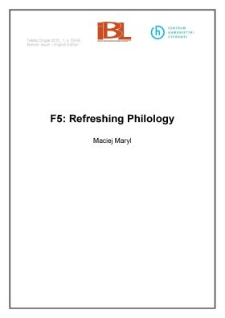- Wyszukaj w całym Repozytorium
- Piśmiennictwo i mapy
- Archeologia
- Baza Młynów
- Nauki przyrodnicze
Wyszukiwanie zaawansowane
Wyszukiwanie zaawansowane
Wyszukiwanie zaawansowane
Wyszukiwanie zaawansowane
Wyszukiwanie zaawansowane

Obiekt
Tytuł: F5: Refreshing Philology
Inny tytuł:
Vol. 1 (2015) - Special Issue - English Edition
Wydawca:
Miejsce wydania:
Opis:
Typ obiektu:
Bibliografia:
1. C. Anderson, Długi ogon. Ekonomia przyszłości – każdy konsument ma głos, trans. B. Ludwiczak, (The Long Tail: Why the Future of Business Is Selling Less of More), (Poznań: Media Rodzina, 2008).
2. R. Bomba, 3 February 2013, the article “Eksperymentalna wizualizacja. Połączenie nauki i sztuki” Bomba.blog, http://radoslawbomba.umcs.lublin.pl/archives/1598 (accessed 04.06.2014).
3. R. Bomba, “Narzędzia cyfrowe jako wyznacznik nowego paradygmatu badań humanistycznych” (“Digital tools as markers if new research paradigm in humanities”) in Zwrot cyfrowy w humanistyce. Internet – Nowe Media – Kultura 2.0, ed. A. Radomski and Radosław Bomba (Lublin: e-naukowiec, 2013).
4. J. Boyd, What is digital humanities, ed. J. Heppler, http://whatisdigitalhumanities.com/, accessed: 04.01.2014.
5. A. Burdick, et al. Digital Humanities, (Cambridge: The MIT Press, 2012).
6. P. Celiński, “Renesansowe korzenie cyfrowego zwrotu” (“Renaissance roots of the digital turn”) in Zwrot cyfrowy w humanistyce. Internet/Nowe Media/Kultura 2.0. (Digital Turn in Humanities. Internet/New Media/Cultutre 2.0), ed. A. Radomski, R. Bomba, (Lublin: E-naukowiec, 2013).
7. G. Crane, D. Bamman and A. Jones “ePhilology: when the books talk to their readers” in A companion to digital literary studies.
8. R. Heuser, L. Le-Khac “A Quantitative Literary History of 2,958 Nineteenth-Century British Novels: The Semantic Cohort Method” Literary Lab Pamphlet, 4, (Stanford: 2012).
9. D.A. Keim, et al. ed. Mastering the information age. Solving problems with visual analytics, (Bad Langensalza: Druckhaus Thomas Müntzer GmbH, 2010), electronic version: http://www.vismaster.eu/wp-content/uploads/2010/11/VisMaster-book- -lowres.pdf (accessed 04.07.2014).
10. F. Moretti, Distant Reading, (London: Verso, 2013).
11. R. Nycz, “W stronę humanistyki innowacyjnej: tekst jako laboratorium. Tradycje, hipotezy, propozycje” (“Towards innovative humanities: text as a laboratory. Traditional hypotheses, proposoals”), Second Texts, 1-2 (2013): 239-255.
12. M. B. Paradowski, “Wizualizacja danych – dużo więcej niż prezentacja” (“Visualizing data – more than presentation”) and “Dekalog analityka danych i infografika – quid, cur, quomodo” (“Data analyst and info-graphic designer Decalogue: quid, cur, quomodo) in M. Kluza, ed. Wizualizacja wiedzy. Od Biblia Pauperum do hipertekstu, (Lublin: Portal Wiedza i Edukacja, 2011).
13. A. Radomski, “Digital storytelling. Kilka słów o wizualizacji wiedzy w humanistyce” (“Digital storytelling. Some remarks on the visualization of knowledge in the humanities”) in Zwrot cyfrowy w humanistyce. Internet – Nowe Media – Kultura 2.0, ed. Andrzej Radomski and Radosław Bomba (Lublin: e-naukowiec, 2013).
14. Report by the European Science Foundation – Research Infrastructures in the Digital Humanities, September 2011, http://www.esf.org/fileadmin/Public_documents/Publications/ spb42_RI_DigitalHumanities.pdf, (accessed 04.07.2014).
15. R. Siemens, S. Schreibman, ed. A companion to digital literary studies, (Oxford: Blackwell, 2008), http://www.digitalhumanities.org/companionDLS/ (accessed 09.16.2013).
16. N. Uddin, Viktor Mayer-Schönberger: Big Data revolution, eTalks, http://etalks.me/viktormay-er-schonberger-big-data-revolution/, 03.31.2013 (accessed 04.06.2014).
Czasopismo/Seria/cykl:
Zeszyt:
Strona pocz.:
Strona końc.:
Szczegółowy typ zasobu:
Format:
Identyfikator zasobu:
oai:rcin.org.pl:59974 ; 0867-0633 ; doi:10.18318/td.2015.en.1.5
Źródło:
IBL PAN, sygn. P.I.2524 ; kliknij tutaj, żeby przejść
Język:
Język streszczenia:
Prawa:
Prawa zastrzeżone - dostęp nieograniczony
Zasady wykorzystania:
Digitalizacja:
Instytut Badań Literackich Polskiej Akademii Nauk
Lokalizacja oryginału:
Biblioteka Instytutu Badań Literackich Polskiej Akademii Nauk
Dofinansowane ze środków:
Program Operacyjny Innowacyjna Gospodarka, lata 2010-2014, Priorytet 2. Infrastruktura strefy B + R ; Unia Europejska. Europejski Fundusz Rozwoju Regionalnego
Dostęp:
Kolekcje, do których przypisany jest obiekt:
- Repozytorium Cyfrowe Instytutów Naukowych > Kolekcje Partnerów > Instytut Badań Literackich PAN > Czasopisma
- Repozytorium Cyfrowe Instytutów Naukowych > Piśmiennictwo > Czasopisma/Artykuły
Data ostatniej modyfikacji:
20 lut 2024
Data dodania obiektu:
28 paź 2016
Liczba pobrań / odtworzeń:
492
Wszystkie dostępne wersje tego obiektu:
https://rcin.org.pl./publication/79756
Wyświetl opis w formacie RDF:
Wyświetl opis w formacie RDFa:
Wyświetl opis w formacie OAI-PMH:
| Nazwa wydania | Data |
|---|---|
| Maryl M. - F5: Refreshing Philology | 20 lut 2024 |
Obiekty Podobne
Uchmański, Janusz
Szczęsna, Ewa

 INSTYTUT ARCHEOLOGII I ETNOLOGII POLSKIEJ AKADEMII NAUK
INSTYTUT ARCHEOLOGII I ETNOLOGII POLSKIEJ AKADEMII NAUK
 INSTYTUT BADAŃ LITERACKICH POLSKIEJ AKADEMII NAUK
INSTYTUT BADAŃ LITERACKICH POLSKIEJ AKADEMII NAUK
 INSTYTUT BADAWCZY LEŚNICTWA
INSTYTUT BADAWCZY LEŚNICTWA
 INSTYTUT BIOLOGII DOŚWIADCZALNEJ IM. MARCELEGO NENCKIEGO POLSKIEJ AKADEMII NAUK
INSTYTUT BIOLOGII DOŚWIADCZALNEJ IM. MARCELEGO NENCKIEGO POLSKIEJ AKADEMII NAUK
 INSTYTUT BIOLOGII SSAKÓW POLSKIEJ AKADEMII NAUK
INSTYTUT BIOLOGII SSAKÓW POLSKIEJ AKADEMII NAUK
 INSTYTUT CHEMII FIZYCZNEJ PAN
INSTYTUT CHEMII FIZYCZNEJ PAN
 INSTYTUT CHEMII ORGANICZNEJ PAN
INSTYTUT CHEMII ORGANICZNEJ PAN
 INSTYTUT FILOZOFII I SOCJOLOGII PAN
INSTYTUT FILOZOFII I SOCJOLOGII PAN
 INSTYTUT GEOGRAFII I PRZESTRZENNEGO ZAGOSPODAROWANIA PAN
INSTYTUT GEOGRAFII I PRZESTRZENNEGO ZAGOSPODAROWANIA PAN
 INSTYTUT HISTORII im. TADEUSZA MANTEUFFLA POLSKIEJ AKADEMII NAUK
INSTYTUT HISTORII im. TADEUSZA MANTEUFFLA POLSKIEJ AKADEMII NAUK
 INSTYTUT JĘZYKA POLSKIEGO POLSKIEJ AKADEMII NAUK
INSTYTUT JĘZYKA POLSKIEGO POLSKIEJ AKADEMII NAUK
 INSTYTUT MATEMATYCZNY PAN
INSTYTUT MATEMATYCZNY PAN
 INSTYTUT MEDYCYNY DOŚWIADCZALNEJ I KLINICZNEJ IM.MIROSŁAWA MOSSAKOWSKIEGO POLSKIEJ AKADEMII NAUK
INSTYTUT MEDYCYNY DOŚWIADCZALNEJ I KLINICZNEJ IM.MIROSŁAWA MOSSAKOWSKIEGO POLSKIEJ AKADEMII NAUK
 INSTYTUT PODSTAWOWYCH PROBLEMÓW TECHNIKI PAN
INSTYTUT PODSTAWOWYCH PROBLEMÓW TECHNIKI PAN
 INSTYTUT SLAWISTYKI PAN
INSTYTUT SLAWISTYKI PAN
 SIEĆ BADAWCZA ŁUKASIEWICZ - INSTYTUT TECHNOLOGII MATERIAŁÓW ELEKTRONICZNYCH
SIEĆ BADAWCZA ŁUKASIEWICZ - INSTYTUT TECHNOLOGII MATERIAŁÓW ELEKTRONICZNYCH
 MUZEUM I INSTYTUT ZOOLOGII POLSKIEJ AKADEMII NAUK
MUZEUM I INSTYTUT ZOOLOGII POLSKIEJ AKADEMII NAUK
 INSTYTUT BADAŃ SYSTEMOWYCH PAN
INSTYTUT BADAŃ SYSTEMOWYCH PAN
 INSTYTUT BOTANIKI IM. WŁADYSŁAWA SZAFERA POLSKIEJ AKADEMII NAUK
INSTYTUT BOTANIKI IM. WŁADYSŁAWA SZAFERA POLSKIEJ AKADEMII NAUK




































